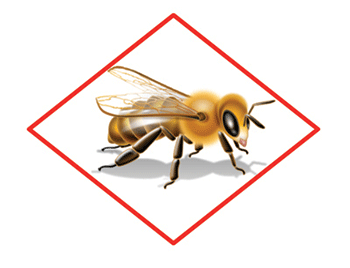Bee Hazard Icon, No 19
Related News
May 15, 2015
May 5, 2015
April 24, 2015
April 2, 2015
March 3, 2015
 Be aware of the Bee Hazard Icon. This Bee Hazard Icon and its accompanying Pollinator Protection Box are now required on the labels of systemic insecticides containing the active ingredients: imidacloprid, dinotefuran, thiamethoxam, or clothiandin, if the product is labeled for foliar application. These systemic insecticides are widely used, both by homeowners and commercial applicators, to control sucking insect pests such as aphids, whiteflies, mealybugs, scale insects, and a wide variety of other pests. These are some of our most effective insecticides for controlling some of our most problematic insect pests. If you plan to use these products, be sure to note, and follow, the pollinator protection precautions listed in the pollinator protection box, and be aware that additional pollinator protection requirements may be listed in other places on the label.
Be aware of the Bee Hazard Icon. This Bee Hazard Icon and its accompanying Pollinator Protection Box are now required on the labels of systemic insecticides containing the active ingredients: imidacloprid, dinotefuran, thiamethoxam, or clothiandin, if the product is labeled for foliar application. These systemic insecticides are widely used, both by homeowners and commercial applicators, to control sucking insect pests such as aphids, whiteflies, mealybugs, scale insects, and a wide variety of other pests. These are some of our most effective insecticides for controlling some of our most problematic insect pests. If you plan to use these products, be sure to note, and follow, the pollinator protection precautions listed in the pollinator protection box, and be aware that additional pollinator protection requirements may be listed in other places on the label.
Don’t be misled by the absence of the Bee Hazard Icon on other insecticides. Absence of the Bee Hazard Icon on a pesticide label does not mean there are no pollinator protection restrictions for that pesticide. Most insecticides can be hazardous to bees and other pollinators and carry explicit pollinator protection instructions and requirements on their labels, even though they do not carry the bee hazard icon. Some fungicides and herbicides also have pollinator protection requirements. Be sure to note and follow pollinator protection requirements for any pesticide you use.
Complying with pollinator protection requirements is important for three key reasons: 1} to protect pollinators from adverse effects of pesticides, 2} to protect pesticide applicators from adverse legal ramifications, and 3} to protect producers and homeowners from the adverse effects of losing labeled uses for effective insecticide products.
Blake Layton, Extension Entomology Specialist, Mississippi State University Extension Service.
The information given here is for educational purposes only. Always read and follow current label directions. Specific commercial products are mentioned as examples only and reference to specific products or trade names is made with the understanding that no discrimination is intended to other products that may also be suitable and appropriately labeled.